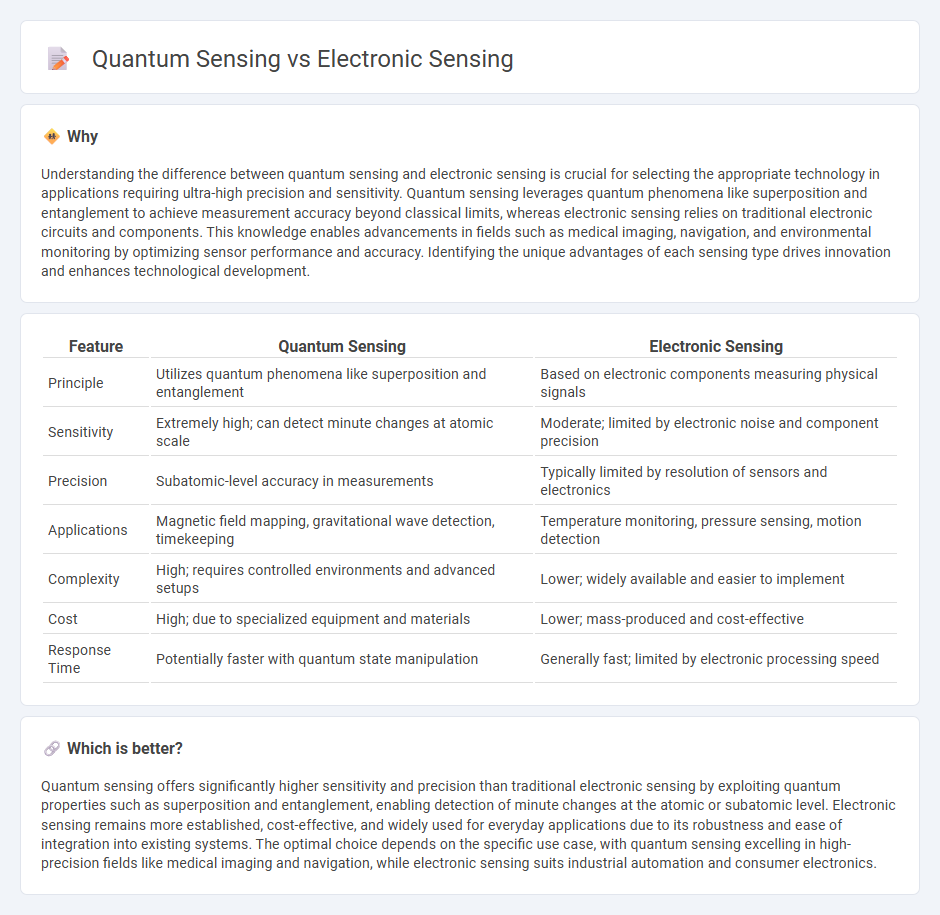
Quantum sensing leverages principles of quantum mechanics, such as superposition and entanglement, to achieve ultra-sensitive measurements beyond the limits of classical electronic sensors. Electronic sensing relies on classical phenomena like voltage, current, and electromagnetic fields to detect physical properties, often with lower sensitivity and precision compared to quantum-based methods. Explore the advancements and applications of quantum sensing to understand its transformative potential in technology.
Why it is important
Understanding the difference between quantum sensing and electronic sensing is crucial for selecting the appropriate technology in applications requiring ultra-high precision and sensitivity. Quantum sensing leverages quantum phenomena like superposition and entanglement to achieve measurement accuracy beyond classical limits, whereas electronic sensing relies on traditional electronic circuits and components. This knowledge enables advancements in fields such as medical imaging, navigation, and environmental monitoring by optimizing sensor performance and accuracy. Identifying the unique advantages of each sensing type drives innovation and enhances technological development.
Comparison Table
| Feature | Quantum Sensing | Electronic Sensing |
|---|---|---|
| Principle | Utilizes quantum phenomena like superposition and entanglement | Based on electronic components measuring physical signals |
| Sensitivity | Extremely high; can detect minute changes at atomic scale | Moderate; limited by electronic noise and component precision |
| Precision | Subatomic-level accuracy in measurements | Typically limited by resolution of sensors and electronics |
| Applications | Magnetic field mapping, gravitational wave detection, timekeeping | Temperature monitoring, pressure sensing, motion detection |
| Complexity | High; requires controlled environments and advanced setups | Lower; widely available and easier to implement |
| Cost | High; due to specialized equipment and materials | Lower; mass-produced and cost-effective |
| Response Time | Potentially faster with quantum state manipulation | Generally fast; limited by electronic processing speed |
Which is better?
Quantum sensing offers significantly higher sensitivity and precision than traditional electronic sensing by exploiting quantum properties such as superposition and entanglement, enabling detection of minute changes at the atomic or subatomic level. Electronic sensing remains more established, cost-effective, and widely used for everyday applications due to its robustness and ease of integration into existing systems. The optimal choice depends on the specific use case, with quantum sensing excelling in high-precision fields like medical imaging and navigation, while electronic sensing suits industrial automation and consumer electronics.
Connection
Quantum sensing and electronic sensing are connected through their shared use of electronic components to detect and measure physical quantities with high precision. Quantum sensors leverage quantum phenomena such as superposition and entanglement to achieve sensitivity beyond classical electronic sensors. Integration of quantum principles into electronic sensing devices enhances measurement accuracy in applications like magnetic field detection and gravitational wave observation.
Key Terms
Transducers
Electronic sensing primarily relies on classical transducers such as piezoelectric, capacitive, and resistive devices that convert physical signals into electrical signals with high sensitivity and reliability. Quantum sensing uses quantum transducers based on phenomena like entanglement and superposition to achieve unprecedented precision and sensitivity beyond classical limits. Explore the latest advancements in transducer technologies driving both electronic and quantum sensing innovations.
Superposition
Electronic sensing relies on classical principles, detecting physical quantities through electrical signals with limited precision. Quantum sensing leverages superposition, allowing particles to exist in multiple states simultaneously, enhancing measurement sensitivity beyond classical limits. Explore the advancements in quantum superposition to understand the future of ultra-precise sensing technologies.
Signal-to-noise ratio
Quantum sensing outperforms traditional electronic sensing by significantly enhancing the signal-to-noise ratio (SNR), leveraging phenomena like quantum entanglement and superposition to detect signals with higher precision and lower noise levels. Electronic sensors, limited by thermal and electronic noise, often struggle to achieve comparable sensitivity and accuracy in measuring weak signals. Explore further to understand how quantum technologies revolutionize sensor performance beyond conventional methods.
Source and External Links
An introduction to electronics: Sensing | OpenLearn - Open University - Electronic sensing involves devices that convert physical phenomena (like sound, light, heat) into electrical signals, enabling functions similar to human senses and applications such as medical imaging and automotive sensors.
Unlock the Future: A guide to Electronic Sensors - IFM - Electronic sensors detect changes in the environment by converting physical variables like temperature, pressure, or motion into measurable electrical signals, facilitating monitoring and automation across various industries.
Introduction to Electronic Sensors - predictable designs - Electronic sensors measure real-world quantities and convert them into electrical signals; they come in analog or digital output forms, with digital sensors offering advantages such as less interference and easier integration in modern electronics.
 dowidth.com
dowidth.com